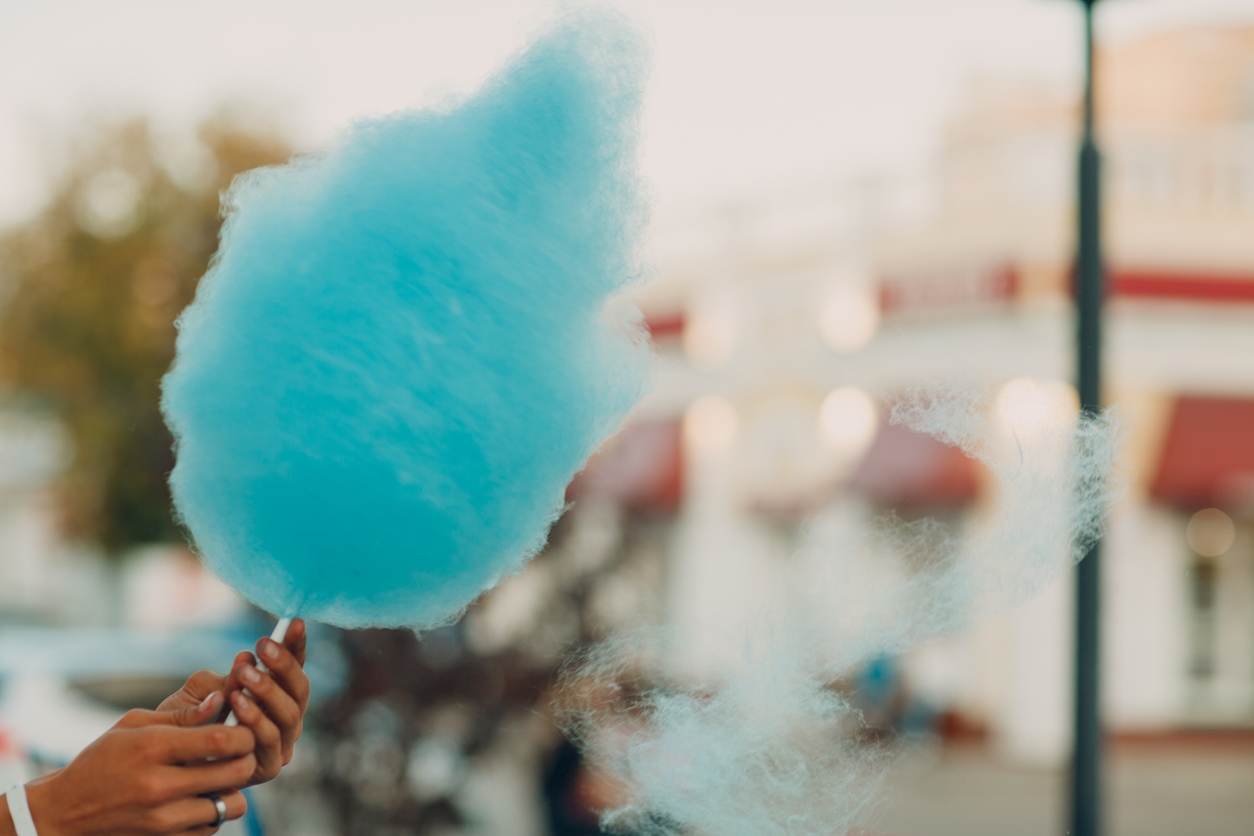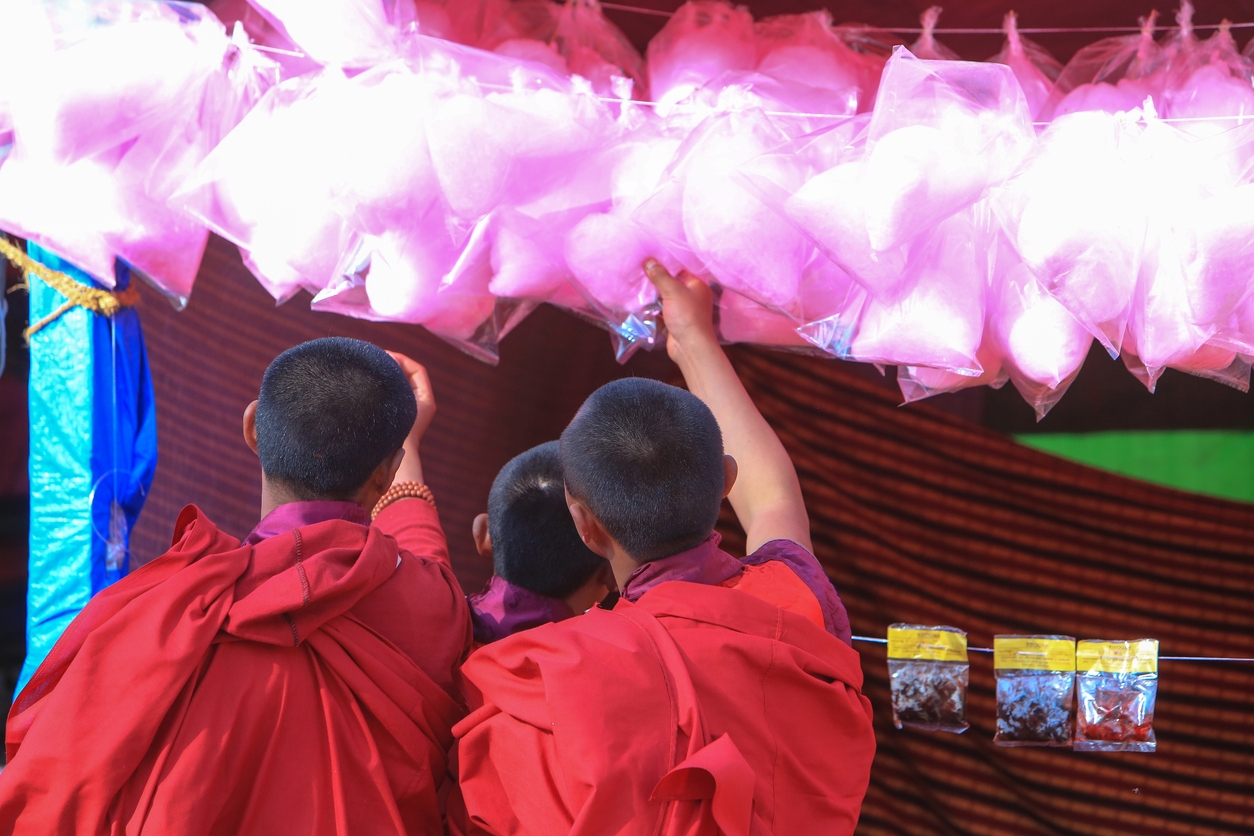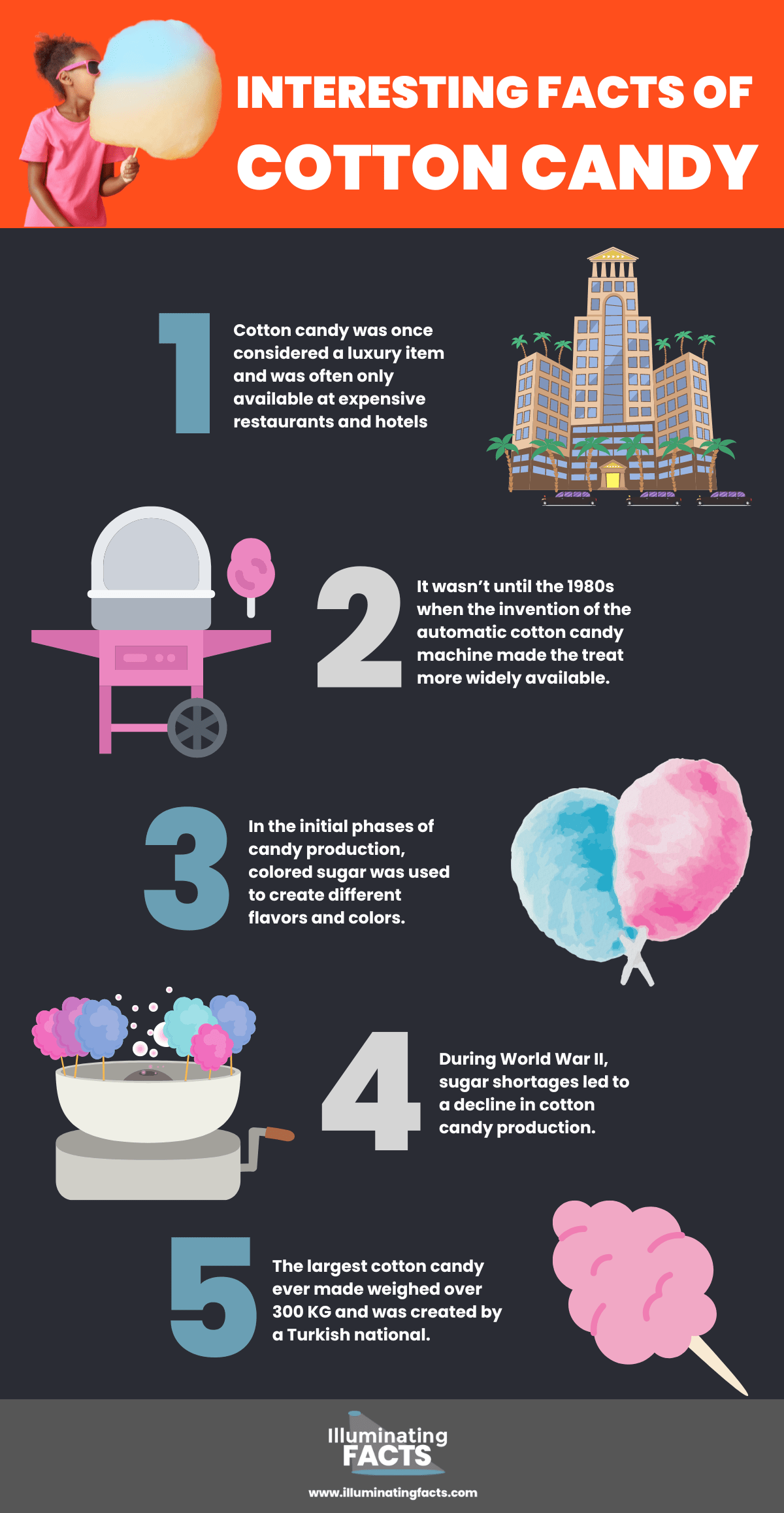Table of Contents
Does the sight of cotton candy make your taste buds dance with joy? Well then, we have something interesting for you in store. Today, we are going to uncover everything about the delicious treat and look at where it stands on the popularity realm.
From its fluffy texture to its vibrant colors, cotton candy is a beloved treat that has been enjoyed by people for generations. But where did it all start? What makes this treat so irresistible? And why do we keep coming back for more?
In this article, we’ll explore the origins, science, and popularity of cotton candy. We’ll analyze how it’s manufactured, the role of centrifugal force, and the ingredients that give it its unique flavor. We’ll also look at the history of this magnificent treat, from its early beginnings as a hand-spun treat to its modern-day popularity at events.
Whether you’re a curious newcomer or an avid cotton candy eater, it’s time to indulge in this sweet treat and learn everything there is to know.
A Brief History
Cotton candy has a rich history that spans over a century. In 1897, dentist William Morrison and confectioner John C. Wharton collaborated to build a machine that spun sugar using a screen. [1] This resulted in a floss-like texture that came to be known as cotton candy.
It took seven years for Morrison and Wharton to debut their new product. In 1904, the makers attended the St. Louis World Fair where they introduced their creation as the “fairy floss.” [2] The fair was a huge success, attracting over 20 million visitors, and Morrison and Wharton sold over 68,000 boxes of cotton candy for a quarter each, making over $17,000 in just eight months.
After the fair, Morrison and Wharton continued to market their cotton candy, selling it to friends and clients in Tennessee and advertising in newspapers like the New York Times. They also established the “Electric Candy Company” to manufacture and distribute their cotton candy machines, which were sold for a price range of 5 to 10 cents a box.
Morrison and Wharton patented their machine, preventing competitors from entering the market until the patent expired in 1921. [3] That year, dentist Josef Lascaux introduced his own cotton candy machine, similar in design to Morrison and Wharton’s, but marketed it as “cotton candy” to distinguish it from “fairy floss.” The name caught on, and today, it’s the name we all know and use.
The 1920s were significant in the history of cotton candy because that was when the cultural shift occurred, and everyone started calling “fairy floss” by the name we know today: “cotton candy.” In 1949, Gold Medal Products introduced a spring-loaded base, which stabilized the rotating components of the cotton candy machine and made it more reliable.
Today, you will find cotton candy being sold throughout the US. It has a special significance to most people as it makes them nostalgic and reminds them of childhood memories. Overall, the pink sweet has come a long way since its invention by Morrison and Wharton.
The Science of Cotton Candy
Cotton candy is a beloved treat that has been enjoyed for generations. However, not many adorers of this sugary, fluffy snack know the science behind it. In this section, we go through the process of making a cotton candy, including the role of centrifugal and other ingredients in the production process.
The Process of Making Cotton Candy
The process of making cotton candy is quite interesting. It involves heating sugar and corn syrup together until they melt into a liquid. The liquid is then spun at high speeds, creating thin strands of sugar. These thin strands then cool and solidify, creating the fluffy cotton candy that we all know and love. [4] The process is simple yet delicate, requiring precise temperature control and careful handling to ensure that the sugar strands are thin and even.
The cotton candy making process is fast-paced, taking only a few seconds to produce a continuous stream of the fluffy treat. However, despite its simple appearance, creating cotton candy requires precision and skill. Thin sugar strands are necessary to form the fluffy texture of cotton candy. The timing of the spinning and cooling processes is crucial to avoid making the sugar too hard or too sticky
Ingredients
Cotton candy is primarily made of highly refined and granulated sugar, which is melted and spun into fine threads to create the delicate texture and fluffy appearance. To produce different flavors and colors, food coloring and flavorings can be added to the sugar before it is melted.
The flavorings can range from fruity to spicy or even savory, while the food coloring can be used to create a rainbow of colors. However, excessive use of either can affect the texture and consistency of the cotton candy. Note that sugar’s quality also plays a crucial role in achieving the desired outcome. Any impurities in the sugar can lead to uneven and lumpy cotton candy.
The Role of Centrifugal Force in Cotton Candy Production
Centrifugal force plays an indispensable role in the cotton candy-making process. [5] The cotton candy machine’s spinning head generates centrifugal force by rotating rapidly, forcing the melted sugar through tiny holes and stretching it into thin threads. As the sugar threads are pulled out, they cool and solidify, forming the characteristic cotton candy texture. The spinning head’s force also ensures that the sugar threads are evenly distributed on the holder, creating a fluffy, consistent product.
We should also mention that centrifugal force applied during the process will impact the final texture of the cotton candy. Too little force results in thicker threads and a coarser texture, while too much force can cause the threads to break and create a less fluffy texture. The spinning head’s design and speed are critical in ensuring the right amount of force is applied to create the perfect cotton candy texture.
The Popularity of Cotton Candy
Cotton candy has gained widespread popularity thanks to its delightful taste and unique texture. The candy’s origins can be traced back to fairs and carnivals, where it first experienced the limelight. Nowadays, cotton candy is a common sight at various events and venues where people gather to have a good time.
Cotton Candy at Fairs, Carnivals, and Other Events
Cotton candy is a classic fair and carnival food that has been around for over a century. It is hard to imagine a carnival or fair without the fluffy, colorful, and delicious cotton candy. Since decades, these events have attracted vendors that specialize in spinning sugar into fluffy confections. Kids and adults both like to consume this sugary snack at such events. In addition to its delicious taste, cotton candy is also visually appealing and provides a fun and unique experience for consumers.
Lately, cotton candy has become a nice addition to non-carnival events, such as corporate events, weddings, and birthday parties. [6] It’s not uncommon to see a cotton candy machine at a party, with guests lining up to enjoy the sweet treat.
Cotton Candy in Pop Culture
Cotton candy’s widespread popularity extends beyond its presence at events and fairs. It has also become a recurring element in popular culture, making appearances in various forms of media. From movies to music videos, cotton candy has become a symbol of youth, fun, and indulgence, captivating audiences across generations. For instance, in the movies “Willy Wonka and the Chocolate Factory” and “The Greatest Showman,” cotton candy adds to the whimsical and magical nature of the story. [7]
Additionally, cotton candy has inspired fashion and design, with its fluffy texture and vibrant colors serving as inspiration for clothing, accessories, and home decor. Its influence on pop culture serves as a testament to its enduring popularity and its ability to bring joy to people of all ages.
The World Loves Cotton Candy
Cotton candy has become a staple for many nationals across the globe. This sweet treat, as we stated below, has been enjoyed for generations and is consumed at various events and in general to date.
In Japan, cotton candy is sold in bright, vibrant colors, like cherry blossom and green tea. In Australia and New Zealand, it is often seen at outdoor events and sporting matches. The Aussies also call it candy floss or fairy floss.
Europeans consume cotton candy in a range of flavors, such as raspberry, bubble gum, and cola. It is often sold at street fairs and carnivals throughout the continent. In the UK, cotton candy is present at seaside resorts and amusement parks, and parents also consider it a savory treat for their children.
South America also has its own version of cotton candy, known as “algodón de azúcar” in Spanish. In Brazil and Argentina, cotton candy is sold in flavors like strawberry and coconut and is a popular treat at festivals and fairs. In the Middle East, cotton candy is commonly referred to as “pashmak.” It is traditionally served with tea and is a popular treat during celebrations and weddings.
In India, cotton candy is known as “buddhi ke baal,” which translates to “old lady’s hair.” It is sold at street markets and is a popular treat for children. In China, cotton candy is known as “dragon’s beard candy” and is a traditional snack that dates back to the Ming Dynasty. It is often made with peanuts or sesame seeds and is a popular treat during Chinese New Year.
No matter where you go in the world, cotton candy is a beloved treat that brings joy to people of all ages. Its fluffy texture, vibrant colors, and delicious flavors have made it a staple at festivals, fairs, and other outdoor events worldwide.
Interesting facts
|
Cotton candy, with its humble origins, has become a popular treat among people of all ages worldwide. Its evolution and lasting appeal are proof of the delight it brings to people’s lives. Whether it’s the classic pink cotton candy at the local fair or new flavors and colors at an amusement park, cotton candy can always put a smile on your face.
Let’s recap some of the key points about the origins of cotton candy:
- Cotton candy was invented by William Morrison and John C. Wharton in 1897 and first introduced at the 1904 World’s Fair in St. Louis.
- Originally called “Fairy Floss,” cotton candy was an instant success, and Morrison and Wharton went on to start the first cotton candy manufacturing company.
- Cotton candy was initially made using a machine called the “spun sugar machine,” which used centrifugal force to spin sugar into thin threads.
- Over time, cotton candy machines became more efficient, and new flavors and colors were introduced to appeal to a wider audience.
Today, cotton candy is a staple at amusement parks, carnivals, and other events around the world, and has even made its way into popular culture. The next time you indulge in this sweet treat, remember its origins and how it has evolved over time to become the cotton candy you know and love today. You’ll be fascinated.
References:
1. The inventor of candy floss was actually a dentist!(2019, March 13). Guiney Dental. https://www.guineydental.ie/the-inventor-of-candy-floss-was-actually-a-dentist-2
2. https://study.com/academy/lesson/cotton-candy-history-facts.html
3. Who invented cotton candy? Inventions and inventors for kids***. (n.d.). Inventors and Inventions for kids***. https://www.who-invented-the.technology/cotton-candy.htm
4. How cotton candy works. (2009, December 3). HowStuffWorks. https://science.howstuffworks.com/innovation/edible-innovations/cotton-candy.htm
5. Why does cotton candy shrink?(2022, November 1). Candy Artisans. https://candy-artisans.com/why-does-cotton-candy-shrink/
6. How gourmet cotton candy is becoming the hottest trend for weddings and events. (n.d.). wkyc.com. https://www.wkyc.com/article/life/food/new-trend-for-weddings-and-events-flavored-cotton-candy/95-5476a475-e881-4695-92fb-941e023be414
7. The greatest Showman is bonkers, but earnestly so. (2017, December 20). Time. https://time.com/5073169/the-greatest-showman-review/






